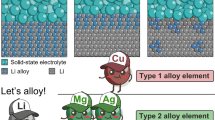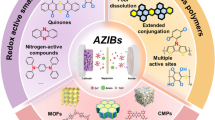Abstract
A detailed investigation has been made on the possibility of synthesizing LiNiO2 through different methods using a variety of precursors and varying heat treating conditions with a view to identify a suitable method to synthesize LiNiO2 and to understand the influence of synthesis method and the nature of the precursors towards the performance characteristics of LiNiO2. In this regard, four different methods,viz., solid-state, organic precursors, solution combustion and microwave methods were adopted involving suitable combinations of lithium and nickel precursors. All the synthesized compounds were characterized for their phase purity (PXRD), local cation environment (FTIR), particle size, surface area, and electrochemical behavior (charge-discharge). Based on the results obtained especially from PXRD and charge-discharge studies, the “all-hydroxide” precursors of Li and Ni were found to be effective in yielding battery active LiNiO2 as far as the solid-state and microwave-assisted methods are concerned. With regard to solution synthesis methods, citrate precursor and the combustion method involving hydrazine hydrate fuel were found to yield better performing LiNiO2, compared to the rest of the combinations attempted in both categories. However, among the wet chemistry based solution methods the present study recommends solution combustion method with hydrazine hydrate as fuel to synthesize electrochemically active LiNiO2 as it was found to exhibit a stable discharge capacity of 177 mAh/g at least up to 20 cycles.
Similar content being viewed by others
References
K. Mizushuma, P.C. Jones, P.J. Wiseman and J.B. Goodenough, Solid State Ionics3–4, 171 (1981).
J.M. Tarascon, E. Wang, F.K. Shokoohi, W.R. Mckinnon and S. Colson, J. Electrochem. Soc.138, 2859 (1991).
Lithium Batteries, New Materials, Developments and Perspectives, (G. Pistoia, Ed.) Elsevier, NY, (1994).
S. Yamada, M. Fujiwara and M. Kanda, J. Power Sources54, 209 (1981).
T. Ohzuku, A Ueda, M. Nagayama, J. Electrochem. Soc.140, 1862 (1993).
T. Ohzuku, H. Komori, K. Sawai, T. Hirai, Chem. Express5, 733 (1990).
J.R. Dahn, E.W. Fuller, M. Obrovac and U. von Sacken, Solid State Ionics69, 265 (1994).
M. Broussley, F. Perton and J. Labat, J. Power Sources43–44, 209 (1994).
Z. Zhang and D. Fouchard, J. Power Sources7, 16 (1998).
T. Ohzuku, A. Ueda, M. Nasatoshi, Y. Iwakoshi, H. Komori, Chem. Express54, 511 (1995).
S.R. Jain, K.C. Adiga and V. Pai Verneker, Combust. Flame40, 71 (1981).
P. Kalyani, N. Kalaiselvi and N. Muniyandi, Mater. Chem. Phys.77, 662 (2002).
N. Kalaiselvi, P. Periasamy, P. Kalyani, V. Sankara sastry, N.G. Renganathan and M. Raghavan, Proc. 8th Asian Conference on Solid State Ionics (ACSSI), Malaysia, Dec. 15–19, 2000, p. 117.
P. Kalyani, N. Kalaiselvi and N. Muniyandi, J. Power Sources123, 53 (2003).
Annual Book of ASTM Standards, ASTM, Philadelphia, USA, Vol. 2, No. 5 (1989) B527.
J. Morales, C. Pérez-Vicente and J.L. Tirado, Mater. Res. Bull.25, 623 (1990).
Joint Commission on Powder Diffraction Standards (JCPDS No: 9-063), International Center for Diffraction Data, Newton Square, PA, 19073.
X. Xiao and Y. Xu, J. Mater. Sci.31, 6449 (1996).
G.T.K. Fey, J.G. Chen, V. Subramanian and T. Osaka, J. Power Sources112, 384 (2002).
P. Barboux, J. M. Tarascon, F.K. Shokoohi, J. Solid State Chem.94, 185 (1991).
W. Li and J.C. Curie, J. Electrochem. Soc.144, 2273 (1997).
J. Himmrich, H. D. Lutz, Solid State Commun.79, 447 (1991).
P. Tarte, A. Rulmont, M. Leigeois-Duyclaerts, R. Cahay and J. M. Winand, Solid State Ionics42, 177 (1990).
A. Rougier G.A. Nazri and C. Julien, Ionics3, 170 (1997).
J. Preudhomme and P. Tarte, Spectrochim. Acta26A, 747 (1970).
E. Zhecheva and R. Stoyanova, Solid State Ionics66, 143 (1993).
C. Julien, M.A. Camacho-Lopez, T. Mohan, S. Chitra, P. Kalyani and S. Gopukumar, Solid State Ionics135, 241 (2000).
C.C. Chang and P.N. Kumta, J. Power Sources57, 44 (1998).
T. Ohzuku, M. Kitagawa and T. Hirai, J. Electrochem. Soc.137, 769 (1990).
Author information
Authors and Affiliations
Corresponding author
Rights and permissions
About this article
Cite this article
Kalyani, P., Kalaiselvi, N., Renganathan, N.G. et al. Evaluation of suitable methods to synthesize battery active LiNiO2 . Ionics 9, 417–427 (2003). https://doi.org/10.1007/BF02376595
Received:
Accepted:
Issue Date:
DOI: https://doi.org/10.1007/BF02376595




